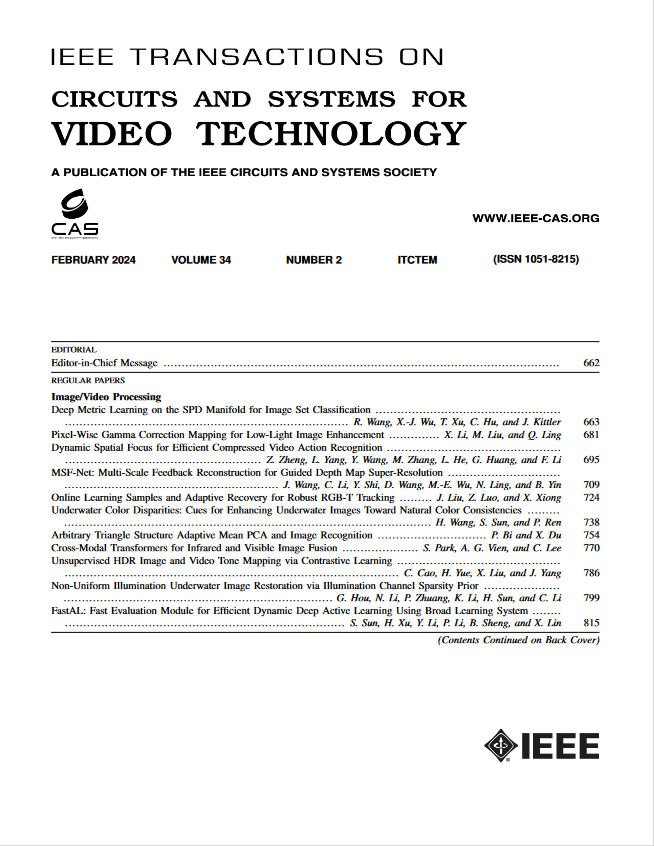SparseTrack: Multi-Object Tracking by Performing Scene Decomposition Based on Pseudo-Depth
IF 8.3
1区 工程技术
Q1 ENGINEERING, ELECTRICAL & ELECTRONIC
IEEE Transactions on Circuits and Systems for Video Technology
Pub Date : 2025-01-01
DOI:10.1109/TCSVT.2024.3524670
引用次数: 0
Abstract
Exploring robust and efficient association methods has always been an important issue in multi-object tracking (MOT). Although existing tracking methods have achieved impressive performance, congestion and frequent occlusions still pose challenging problems in multi-object tracking. We reveal that performing sparse decomposition on dense scenes is a crucial step to enhance the performance of associating occluded targets. To this end, we propose a pseudo-depth estimation method for obtaining the relative depth of targets from 2D images. Secondly, we design a depth cascading matching (DCM) algorithm, which can use the obtained depth information to convert a dense target set into multiple sparse target subsets and perform data association on these sparse target subsets in order from near to far. By integrating the pseudo-depth method and the DCM strategy into the data association process, we propose a new tracker, called SparseTrack. SparseTrack provides a new perspective for solving the challenging crowded scene MOT problem. Only using IoU matching, SparseTrack achieves comparable performance with the state-of-the-art (SOTA) methods on the MOT17 and MOT20 benchmarks. Code and models are publicly available atSparseTrack:基于伪深度执行场景分解的多目标跟踪
探索鲁棒高效的关联方法一直是多目标跟踪中的重要问题。尽管现有的跟踪方法已经取得了令人印象深刻的性能,但拥堵和频繁的闭塞仍然是多目标跟踪的挑战问题。在密集场景上进行稀疏分解是提高被遮挡目标关联性能的关键步骤。为此,我们提出了一种从二维图像中获取目标相对深度的伪深度估计方法。其次,设计了一种深度级联匹配(DCM)算法,利用得到的深度信息将一个密集目标集转换成多个稀疏目标子集,并在这些稀疏目标子集上按远近顺序进行数据关联。通过将伪深度方法和DCM策略集成到数据关联过程中,提出了一种新的跟踪器,称为SparseTrack。SparseTrack为解决具有挑战性的拥挤场景MOT问题提供了新的视角。仅使用IoU匹配,SparseTrack在MOT17和MOT20基准测试中实现了与最先进(SOTA)方法相当的性能。代码和模型可在https://github.com/hustvl/SparseTrack上公开获得。
本文章由计算机程序翻译,如有差异,请以英文原文为准。
求助全文
约1分钟内获得全文
求助全文
来源期刊
CiteScore
13.80
自引率
27.40%
发文量
660
审稿时长
5 months
期刊介绍:
The IEEE Transactions on Circuits and Systems for Video Technology (TCSVT) is dedicated to covering all aspects of video technologies from a circuits and systems perspective. We encourage submissions of general, theoretical, and application-oriented papers related to image and video acquisition, representation, presentation, and display. Additionally, we welcome contributions in areas such as processing, filtering, and transforms; analysis and synthesis; learning and understanding; compression, transmission, communication, and networking; as well as storage, retrieval, indexing, and search. Furthermore, papers focusing on hardware and software design and implementation are highly valued. Join us in advancing the field of video technology through innovative research and insights.

 求助内容:
求助内容: 应助结果提醒方式:
应助结果提醒方式:


